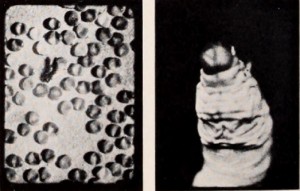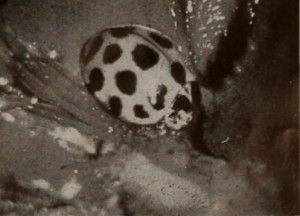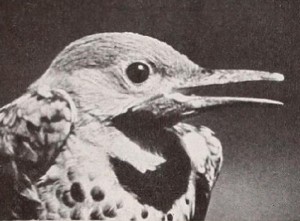
"Arthur R. Powell of Asuza, California, decided to photograph the silkworm from the egg to its full growth. For some of us who are of a nervous temperament this may seem a tedious task to set for oneself, but Powell started it and determined to see it through to the bitter end." American Cinematographer, Oct. 1932, 28.

"In The Ladybird, W. G. Nicholls has told the story of the life of the common ladybug — remember "Ladybug, ladybug, fly away home . . ."? — in a film that is entertainingly instructive as well as distinguished by excellent photography, composition and editing. Many of the extreme closeups of the tiny ladybird as it goes through the various stages of its insect life-cycle are indeed remarkable. Mr. Nicholls's skill in closeup cinematography is particularly well demonstrated in the series of scenes featuring the ladybird's value as a devourer of the aphids that so bother rose growers. A narrative that is educative and well written creates a feeling of respect for the ladybird as a friend to man in his constant struggle against destructive insects. Here is a nature study which is first class in every way." Movie Makers, Dec. 1953, 334.
"Dr. Karl von Frisch performs some of the experiments which led to his discovery of the language of the bees. Explains the system by which bees communicate information about direction and distance. Emphasizes the importance of curiosity in scientific research." via WorldCat

"Henry E. Hird offers the framework of a timely continuity plan for a scientific record in A Letter. A naturalist father writes a film letter to his sailor son who shares the father's scientific interest in bird and insect life, as well as in floral beauty. We see the father writing and the son reading a letter, the information in which is brought to life in film. Mr. Hird is a very capable observer and movie maker, and the combination of these abilities has enabled him to offer, in this informal style, a wealth of information. Extraordinary sequences of nesting birds are included." Movie Makers, Dec. 1943, 477.
"Lily Was A Lady: Roy C. Wilcox failed to state what camera he used in filming this fine study of the habits of Lily, a praying mantis, but both his color photography and his editing skill have netted a highly interesting film about one of nature's queerest insects." American Cinematographer, May. 1951, 192.
"Listen is an appropriate title for a film that won the MPD Sound Award for Richard Garman of Salt Lake City. In 9 minutes of color you will learn the life story of a cricket. You may have heard the sound of its chirping all your life, but now you will be face to face with it just as you've always heard it - then in slow motion (or speed) and then even in slower motion (or speed). You have got it to hear it to believe it" PSA Journal, Nov. 1969, 57.
Marshland Mysteries is a version of Unseld's film Swamp Song.
"Monarch Butterfly Story: This film, with its carefully written and recorded narration, is equally meticulous in its photography which chronicles the life-cycle of the Monarch butterfly from egg to adult. Major Anderson and his wife Claire Louise have collaborated in producing one of the finest studies of insect life ever produced by a non-professional film maker, and already one large educational film distributor is negotiating for its purchase. Employing two Bolex H-16 cameras, the Andersons have produced several excellent sequences in time-lapse photography aided by equipment home-made for the purpose by Mr. Anderson. The picture opens with scenes showing adult Monarchs in natual habitat. Interesting facts regarding the butterfly are told in the narration. Then the egg-laying period is shown, followed by closeups of the egg, hatching of the pupa, and it ultimate growth to an adult through the various stages of metamorphosis natural to the Monarch. It is the meticulous ultra-closeup photography and the perfectly executed time-lapse camera work that gives this production its class, and easily makes it one of the best 16mm color films of the year." American Cinematographer, May. 1951, 190.
Total Pages: 5